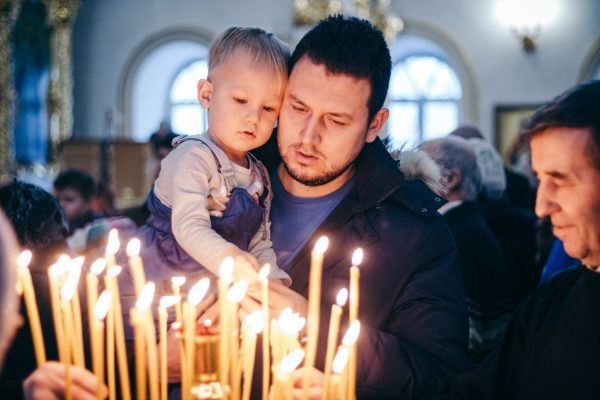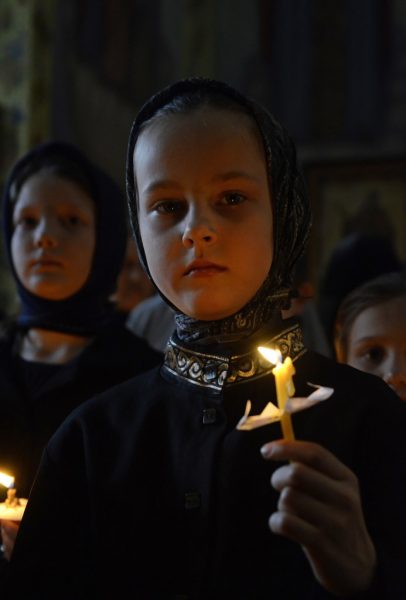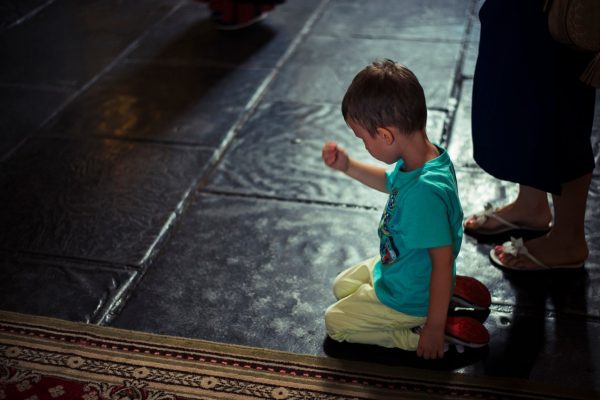My husband and I made what I consider in hindsight to be a major mistake in introducing our daughter Katie, now five, to the life of the Church. When she was a toddler, we brought children’s picture prayer books, Bible story books, and religious coloring books with us to services, and encouraged her to sit quietly looking at the pictures or coloring. This allowed us parents to pray and participate in the services, and kept her relatively quiet so those around us weren’t disturbed… she was in Church very regularly, soaking in the smells and sounds of worship, and “learned” about Jesus with materials “appropriate” for her age. These were good things, the right things to do — or so we thought!
Unfortunately, we gave Katie a completely incorrect notion of what we Christians actually do in Church, and we have spent the past two years “unteaching” our mistake. It has been a very, very frustrating process!
What are we supposed to do in Church?
The word ‘liturgy’ means work! Everyone — men and women, adults and children — works together in Church to praise God and ask for His mercy and help, led by the priest and deacons. This work of worship is hard, and there are no shortcuts.
The services of the Church are also where we learn about God — the Father, Son, and Holy Spirit — by learning and then participating in the living Tradition of the Church. We do what the Apostles did, because they taught their parish families what Jesus and the Holy Spirit revealed to them, and those early Christians taught their children, and those children taught their children… The Faith we Orthodox Christians live is the Faith of the Apostles, “deposited” with us through the Church.
Teaching a child to be an Orthodox Christian — and what that means every day — takes a huge commitment and constant effort on the part of the parents and godparents. Here are some of the things we learned the hard way, or were shown to us by people much wiser…

Photo: ganduridinierusalim.com
Age by Age, Stage by Stage
Before Birth — Before your child is born, you can “set the stage” for his or her introduction into the life of the Church. Choose godparents for your child from your own “home parish” who attend services regularly and participate with joy, and who make a great effort to live the Faith in their everyday lives. Ask your priest for his advice about people you are considering asking to be your child’s godparents: he may recommend someone you had not considered, or warn you that someone you were considering is overburdened or struggling, and not a good choice at this time.
Ultimately, your child’s godparents will share the burden of teaching your child about the Faith… pick a good teacher and role model!
Infants & Toddlers — Make a point to hold your child up so that he can see what is going on around the Church during services. During a recent monastery visit, I watched dumbfounded as the Abbess scooped up a toddler in a hug as Vigil began, then moved slowly around the nave with the little girl (and her doll) during the service. She touched everything she could reach, she sang as Mother sang, and two hours later she fell asleep in Mother’s embrace. Wow! I thought, that’s how to introduce a child to the kingdom of God!
Point out the censing of the Church and the clouds of smoke, the gleaming icons, the flickering candles, the music, and the entrances (or ‘parades’) to keep his attention focused on the worship. Keep up a whispering commentary if you can (even if he is too young for explanation, say the names of things, and that they are “for God” and “beautiful”).
Don’t be afraid to move around the back and sides of the nave with your child so that he can touch the icon of St. Herman, or pick up an unlit candle, or breathe in the incense, or see the view right up the center aisle. Let him “explore” this holy environment with you as a guide… the side benefit of this is that your child will probably be too fascinated to fuss during services, and he’ll learn to be completely welcome in the house of God.
Does this mean that toddlers, or even older children, should be allowed to wander around on their own, explore under the pews, hide behind baptismal font at the back of the nave, or roll on the floor in the center aisle during the sermon? No, absolutely not! Children still need to show proper respect for the holy place where they are, the house of God. And the parents and godparents need to be at their side to explain what they’re supposed to be doing, and illustrate both proper behavior and attitude by example. (Fr. David Barr’s wonderful article on Church etiquette, “Some Things You Should Know while in Church,” appeared in the Summer 1997 issue of OFL, and is available on the internet on at least 5 different sites, including www.theologic.com/oflweb.)
Pre-Schoolers — Encourage your child to sing softly with you during the litanies and hymns, and work with him at home to learn the Our Father as soon as he is able to understand what he’s asked to repeat. Remind him to make the sign of the cross or bow toward the priest or deacon when it’s appropriate, and praise him when he does these things by himself at the right times.
Repeat over and over that it’s his job to pray, too, so that God can “hear” him and “see” him… he’s part of the “team” and can “play” just like the adults and older kids. You may even want to give him a picture prayer book so he can follow along with the main points of the service (matching the picture in the book to what he sees), and do what mom, dad, and the other adults are doing (turning pages together as the service progresses).
Eventually, you’ll have to “stay put” during services rather than wander together exploring, usually when a child is too heavy to hold comfortably for a long period. Choose a place to stand in the nave as close to the front as possible (or comfortable, if you still need to make occasional mid-service exits with younger children) and on the center aisle, so that your child can stand on his own and be able to see. Don’t worry if you child “sticks out” in the aisle a bit; our daughter sometimes “blends in” with the altar boys holding candles during the gospel (which is read in the center of the nave in our parish, since we have a deacon), but she can see and hear everything that goes on.
This age is also when the “deep theological questions” usually start: What is Father doing with that funny candlestick? Why is he washing his hands? Why is he holding up that piece of bread? For the parent, this is when the “real” work of teaching the Faith begins!
Encourage your child to ask you, your spouse, and his godparents questions quietly during the service, and whisper an answer as he’s watching the service progress, if possible. If you don’t know an answer, make a point to say, “I don’t know. We’ll ask Father at coffee hour. You remind me, okay?”
As a parent, you’ll need to be prepared for a non-stop deluge of questions. Read up on the history and symbolism of the services your parish offers regularly: the Divine Liturgy at minimum, and Vespers, Matins, Hours, the wedding service, and Baptism/Chrismation as you are able. Take a few minutes to look up the events being celebrated in an upcoming feast, and look at the icon as a “story book” before going to the church. There are many excellent resources for these, including articles in your parish bulletin and OFL.

Photo: https://vk.com/simbirskaya_mitropolia
Kindergarteners — As soon as your child is able to recognize words on a page (even by memory, instead of actually reading), have him follow along with the service in your parish’s adult service book. Ask him to keep track of the “Lord, have mercy”s for you as he sings, and to let you know when it’s time for the Gospel or Our Father. This is a wonderful way to keep him involved and interested, and to really illustrate the point that we are all working together in the services: we all follow the same “script”, just like our grandparents, and their grandparents, and even St. Nicholas (or his/her patron saint) did!
Encouraging questions has worked for our family, I’m happy to say: our daughter Katie now points out changes in vestment color (along with her theory as to what the new color means), and offers her explanation of why something is happening if she hasn’t seen it before (in her memory). For example, on Holy Friday she told me as the plaschanitsa (or ‘winding sheet’) was taken on procession, “See, Father is carrying Jesus around and around, and putting Him in Joseph’s tomb,” and when we approached to venerate His body, “There’s a cloth over His face now. Don’t lift it, because He’s dead. That’s his mummy-cloth.” She has been listening!
The most difficult “unlearning” task we faced personally (and are still working on) was teaching our daughter how to stand for prayer. She was used to sitting while we stood, because we allowed her to as a toddler, and praised her when she was still and quiet. We started teaching her to stand last year by reminding her to stand during entrances, the Gospel, the Cherubic Hymn, the Creed and Our Father, and the Anaphora, and then encouraged her to stand “with the big people” for more and more of the service. Occasionally, she will stand for a whole service now, but most of the time she gets tired and sits for a few minutes at a time. We don’t force her, but continue to remind her when a “time to stand” comes along. Sometimes, she gets right up without missing a beat, but other times it’s, “Oh, Mom!” I just know I’ll be happy when she stands all the time, because I get light-headed turning around and bending over to answer her questions!

Photo: Irina Konovalova, svjatoynarym.ru
Back on the Right Track
We’ve gotten back on the right track, I think, in teaching our daughter that the Church’s services are for worship and learning about God together, not for reading and drawing on your own. It is a gradual process, and we still suffer setbacks from time to time: standing with a good friend, socializing is more appealing than praying; near a group of younger children, coloring or “babysitting” are enticing. But we keep reminding…
Don’t give up on your own efforts to draw your child — whatever his or her age — into the worshipping community of the Church. It is worth it!

















